Poetry as creative practice has powerful abilities to affect change, and is a potential source for alternative knowledge, new awareness, dissemination and critical reflection. This paper challenges the liminal position of poetry and prose fiction in architectural design education. The key focus is a consideration of the role of poetry and prose fiction within the architectural design studio context, whereby its writing is harnessed for its transformative potential, enabling students of architecture to better envision, develop and communicate their designs. Architects pursue parallel aims of user experience and functional outcomes when they design, yet achieving this balance is often a struggle for students. This paper developed from observations by the author, using a method of poetry and prose fiction to foster the students’ abilities to critically engage, produce and reflect. The design activities employed are discussed and a series of examples from studio work used to illustrate the learning development and outcomes. A discussion of the significance of poetry to architectural students follows this, concluding with recommendations for teaching and practice.
Keywords: Poetry - Architectural design - Pedagogy
1. Introduction
‘Without imagination and belief, ideas about better working, healing, living and learning environments cannot properly be explored… What is an architect for, when they can’t stick their neck out for good ideas that may just work?’ (Golembiewski 2014)
Architects pursue parallel aims of user experience and functional outcomes when they design, yet achieving this balance is often a struggle for the students within the undergraduate and graduate classroom teaching architectural design. In particular, where briefs are particularly complex in nature, or unfamiliar to the students, or require exceptional rigour in challenging current approaches to contemporary design within particular typologies, gaps may begin to emerge in the students’ abilities to critically engage, produce and reflect. This paper developed from observations by the author when teaching students in architectural design studios. The author explored the role of poetry and prose fiction as a key methodology within design process, the methods and outcomes of which are the focus of this paper. Firstly, an overview of the typical techniques students employ in design studios to interrogate design briefs are presented. Secondly, the processes to integrate poetry and prose fiction into the design process are detailed, highlighting the unusual and innovative nature of this process to the teaching of architectural design. Thirdly, a series of examples from studio work are presented to illustrate a series of key learning outcomes arising from this particular design methodology. A discussion of the significance of poetry and prose fiction to architectural students follows this, concluding with recommendations for teaching and practice.
2. The design process
This paper challenges the liminal position of poetry and prose fiction in architectural design education. Architects typically value the role of the drawing as a means to communicate and express ideas, and this skill is regarded as one which separates architects from other professions. For centuries architects have used a variety of art-based means to convey their conceptual ideas about space-making. Techniques to create drawings include hand sketching, collage, materials assemblage, drafting and rendering (Marinic 2011). The composition and arrangement of drawings is reinforced by many as having ‘timeless relevance’ (Marinic 2011: 1833) and further, architecture as a discipline ‘is often regarded as an exclusively visual affair’ (Caballero 2014: 156). This paper explores the notion that both language and images often exhibit the same degree of figurativeness and interrogative ability, and emphasises the use of poetry and prose fiction as a means to enhance the figurative, multimodal – verbal and visual – and enactive quality of architecture.
The design process and design teaching typically does not integrate the writing of or reflection on poetry and prose fiction. The traditional arrangement of the main design phases are as follows: predesign, schematic design, design development, and construction of documents phases (Soliman 2017). Collidge stresses that the architectural design process must achieve its objectives in order of priority; the highest order of priority being the production of the main design solution (Collidge 2013). The refinement of project details should support or complement this main solution (Collidge 2013).
Sketching is one of the main approaches for a student of architecture to communicate his or her design; it allows the presentation of ideas and potential design solutions across many phases (Abdelhameed 2011). Sketching is also a means to capture and record ideas, and evaluate and refine existing ideas (Ferguson 1992). This is like ‘making a conversation with oneself’ (Goldschmidt 2003: 73). Sketching serves as a vital thinking tool for designers (Suwa, Tversky, Gero, & Purcell 2001). Providing visual displays increases architects’ rated creativity in their designing, and designers depict hidden ideas in visual displays (Goldschmidt 2003). Thus, sketches may provide clues for the detection of unintended design features (Suwa et al. 2001), and is a central tool by which students learn architectural design.
Most studies on the design process indicate it is quite fluid and does not follow strict rules (Kowaltowski, Bianchi, & Teixeira de Paiva 2009). This creative process is considered complex, and focused on solving ‘wicked problems’ (Rittel & Webber 1973). This wickedness manifests as a continuous redefinition of the design problem during the design process, and the impossibility of testing the plethora of solutions (Coyne 2005).
3. Poetry and prose fiction in the design process
The author guided students in design studios across several semesters in methods to integrate poetry and prose fiction into their design process. Student responses to this were gathered through mid- and end-of-semester surveys relating to the specific learning outcomes of methods employed in studio, and administered by the author,[i] and through end-of-semester student evaluation surveys, administered by the University of Melbourne. The design process explored by the author in this domain of practice is to flow from (1) prose fiction through (2) creative reflection, and then to (3) creative/poetic/metaphoric expression, to achieve (4) new drawings and spatial conceptualisations. This process may be repeated multiple times across the development of a design solution. This process disrupts the student’s habitual ways of seeing and habits of making; the way they execute design as practice. Through encouraging students to explore methods of creation beyond those they conventionally adopt, or are comfortable with, a transformation is possible in their understanding of the role of architecture and their own professional competency.
The process of design operated on the notion that the ability to map, test and evaluate knowledge across different modes lies at the heart of creativity (Caballero 2014). This multi-modal approach is informed by contemporary literature which emphasises a shift from text-centric communication to multimodal delivery (Flewitt, Hampel, Hauck, & Lancaster 2009; Jewitt 2009; Leander & Vasudevan 2009) in order to increase and diversify communication processes. Understanding the affordance provided by different modalities can also have transformative abilities for the students in a design studio context. The goals of the design tasks/activities were: to foster flexibility and fluency in the translation of information and knowledge development in verbal, textual and drawn forms; and to explore design possibilities afforded by textual and visual forms as coherent parts of the same design proposition or intent. Activities included:
1. Developing poetry/prose fiction in response to visual material
2. Developing visual material in response to poetry/prose fiction
3. Identifying architectural and/or spatial components in texts/narratives
4. Identifying and categorising descriptive texts (visual and textual) from evaluative/reflective texts
5. Diagramming/representing textual logic or hierarchy (visual or textual)
6. Identifying metaphors, or previously undetected issues in the material (visual or textual)
The activities numbered four to six dealt with more abstract, reflective practice and knowledge making, often used for evaluation or analysis purposes, and required a higher level of maturity of design thinking. The students’ own poetry and prose fiction was at once inspiration, a tool for imagining and briefing, and a communicative voice in representation of architectural space. For some students, these passages proved very effective in clarifying ideas related to brief, programme and spatial experience.
4. Design studio outcomes
Examples from three design studios are used for discussion in this paper. The first design studio brief was for a multi-program tower including a business headquarters, retail space, boutique hotel, and therapeutic mental health service. The second studio brief encouraged students to design a house for unrequited love, where characters from student-chosen novels or poems, dealing with unrequited love, would become their clients for the design project. The third studio brief began with students reflecting on a piece of architecture which ‘haunted their memory’ and using this to inform the design of a building at a public scale, such as a library or museum.
The students developed sets of metaphoric jargon to speak about various aspects of the design problem, from functional to structural to conceptual properties. This is not unusual; metaphoric jargon used commonly in architectural practice to describe the functional and structural properties of buildings include ‘spine’, ‘bowels’, ‘mechanics’; a building’s pathologies may be described using such terms as ‘fatigue’, ‘blister’, or ‘bleeding’; a building’s appearance may be described using such terms as ‘muscular’ or ‘sinuous’ (Caballero 2014). Many of these terms bring together functional and visual information. The students’ writing often conveyed sensory information related to textures, light sound, and similar, aiming to capture the embodied, multisensory and multi-modal experiences that is the inhabitation of architectural space. Words such as ‘fabric’, ‘grain’ and ‘skin’ blend architectural textual properties with the haptic realm and the perceptual experiences the students were inviting with their designing. These perceptual experiences were clarified in the writings, and then tested through the making of drawings. Student A’s writing included descriptions of spaces which were ‘concrete breaths’ alluding to the sensory experience of the space. Terms such as ‘compression’ and ‘release’ capture the feeling of inhabitation in the architecture envisaged; a connecting of visual and haptic information, to be translated to new drawings (see Figures 1 and 2). This was a highly sensuous approach to built space, transcending the purely visual matter of architecture, and inviting an embodied, multisensory encounter. The metaphor here is a key cognitive and linguistic mechanism whereby knowledge may be developed, refined, translated and legitimised in architecture.
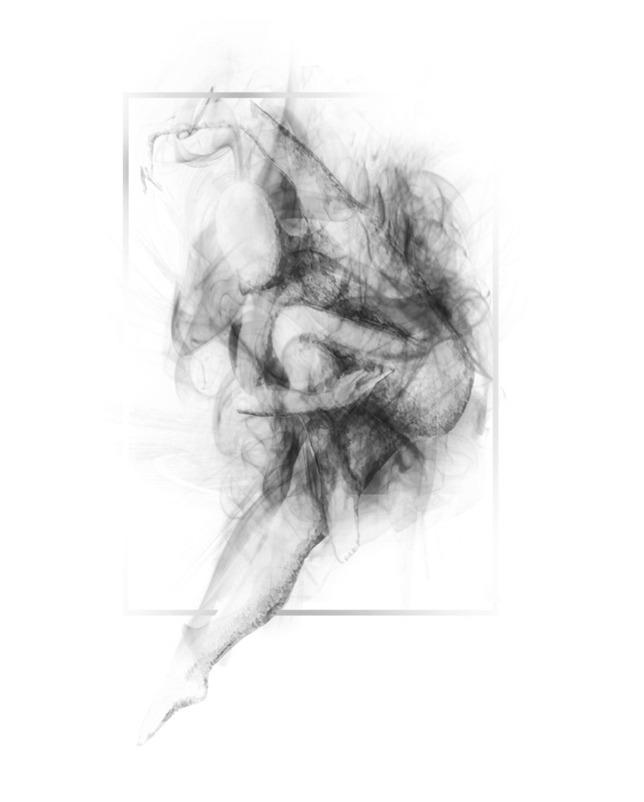
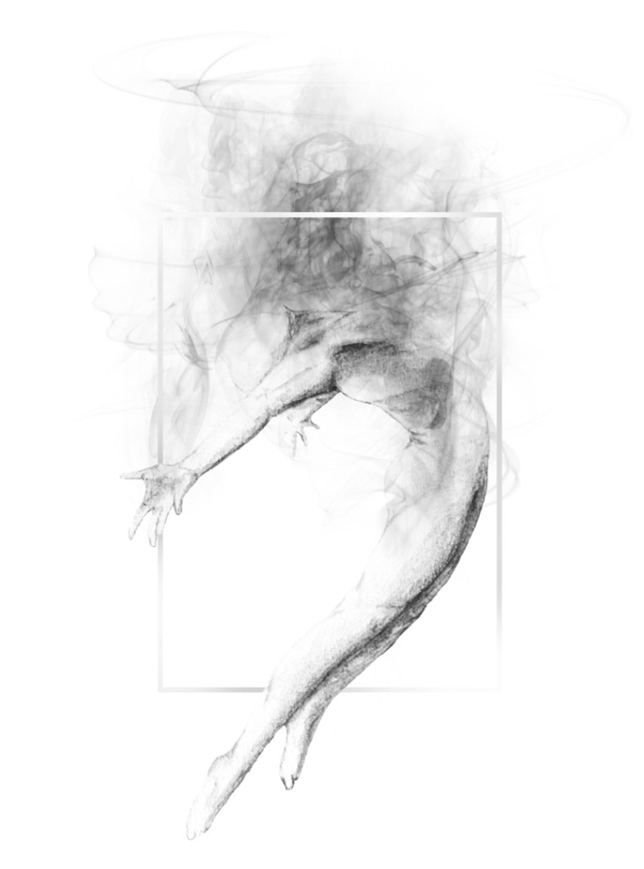
What emerged from the three design studios was that poetry and prose fiction in the design process improved the students’ design practice in a variety of key ways, grouped into three themes: (1) by opening the students up to new perspectives that were either different or more holistic than those previously held; (2) by stimulating critical reflection; and (3) by providing a means for personal connection and emotional response, which helped to shape a self awareness about design response and agenda. These three notions are examined below, illustrated with examples of student work to support the discussion.
4.1 New perspectives
Introducing poetry and prose fiction into the design studio assisted the students to conceive of or become aware of new ways of seeing and representing the world and associated values. For some, developing visual material in response to poetry/prose fiction texts served to provide a means by which the students could see the world from another perspective, or re-frame a value differently from their habitual ways of thinking. For others, their perspectives widened to be more holistic.
Student B began with the novel ‘Junky’ by William S. Burrows, with the view that a drug addiction was akin to unrequited love (the theme of the studio), and worthy of exploration. The student interrogated the experience of a drug addict in 1950s New York through the writing of her own prose, aiming to enhance her own conceptualisation of this characters’ way of seeing and perceiving the world. She then manifest these ideas from her own prose through a wearable garment and a second iteration of prose writing developing from, and interrogating, the knowledge gained in the wearable garment (see Figure 3).
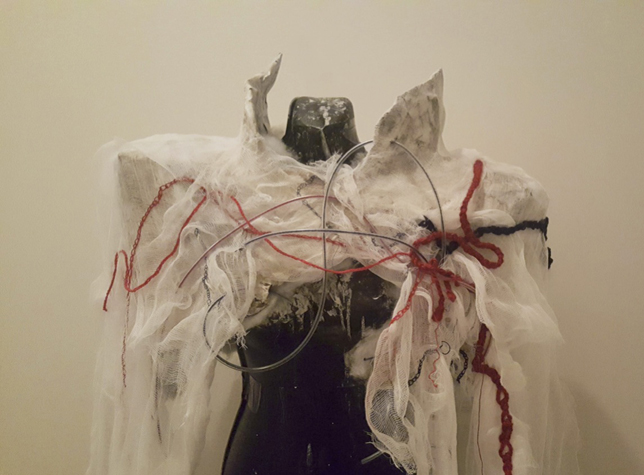
‘What knowledge it is to realise that we are filled with veins that could be fuller, that could accelerate the highways to the brain! Let’s race there through blood flow.
And after tearing up and out the roads and the streams, after they’ve shrunk, we find other places to help us fall into ascension.
And it is addictive and exhilarating and sacred: the process of shooting up.
And so we go on picking and tearing at the bugs, the trespassers, in our system.’[v]
This process allowed Student B to interrogate her own knowledge making across different modes, promoting a more abstract, reflective practice, and a self-reported greater capacity to think and act critically in producing design work.
4.2 Stimulating critical reflection
Saban discusses how fiction can function as a medium of reflection through the use of metaphor (Saban 2006). Deshler explains how metaphors are used in meaning making processes, and that by reflecting upon the metaphors we apply to worldviews and values can be a powerful means to critically self-reflect (Deshler 1990). Students engaging with poetry and prose fiction in the design studio context in turn more readily critically questioned themselves, in their design process and actions, or questioned the world around them, through unpacking assumptions and values which they had transposed onto their designing.
Student C’s work explored notions of sexuality, gender and body image in architectural space. Designing a wellness spa, the student began with analysing discourse on sexuality and gender in architecture, and reading of poetry and prose fiction with these themes. This was then used to inform a series of poetic writings imaging key spaces in the anticipated final design project. A collage was then developed based on each of the poetic writings, where the imagery in a sense became a performance of the poetic writing (see prose and Figures 4-7 below).




Here the writing and images together explores concepts of gender, sexuality and body image in architectural space, where key notions or points of exploration are unpacked and manifest spatially. The writing of prose served to clarify and to explore these concepts, and how this might be inferred or manifest using architectural and spatial language. This led to a higher level of criticality, whereby the experience of the inhabitant of the design project is explored in spatial terms and design dialogue. The poetic text written by the student and the architectural imagery generated operate in tandem to mirror the other’s sense of artfulness and deliberation, implicitness and allusiveness, spatial atmospheres and ambiguity. The new drawings become performances of the writing. Student C’s work also further explores the role of the haptic system in experiencing three-dimensionality. The prose combine feeling, doing and self-perception, expressing a holistic experience. By choosing and exploiting different metaphors, and reflecting and identifying this, the student was able to foreground, and downplay, various aspects of the design solution to accord with this, and in turn the argument inherent in the writing.
4.3 Personal connection and emotional response
Characters and metaphors within poetry and prose fiction served as stimuli for strong levels of personal connection and emotional response amongst the students. The characters in particular, serve as a kind of ‘evocative object’ (Turkle 2007), to use Turkle’s term, an entity which serves as an intellectual and emotional catalyst. Students responded to these evocative objects, the characters, intellectually and emotionally, becoming better equipped to concretise abstract concepts and make sense of the relationships, behaviour settings, values and assumptions they were translating from the writing into architectural space.
Students spoke about how they related to characters, users or scenes through their own personal life experiences, which in turn helped them to conceptualise these experiences in new ways. In some cases, the students recognised parts of themselves in the characters. Student D’s project explored issues of grief and loss in the design of a crematorium for Melbourne’s central business district. Responding to existing prose fiction and developing her own poetic writing, the student interrogated the stages of the journey of grief surrounding the death of a loved one. This writing allowed her to develop a deeper connection to this experience, and understand the complex needs and emotions associated with death. She developed these writings into collages (see Figure 8) which tested these explorations in architectural space.
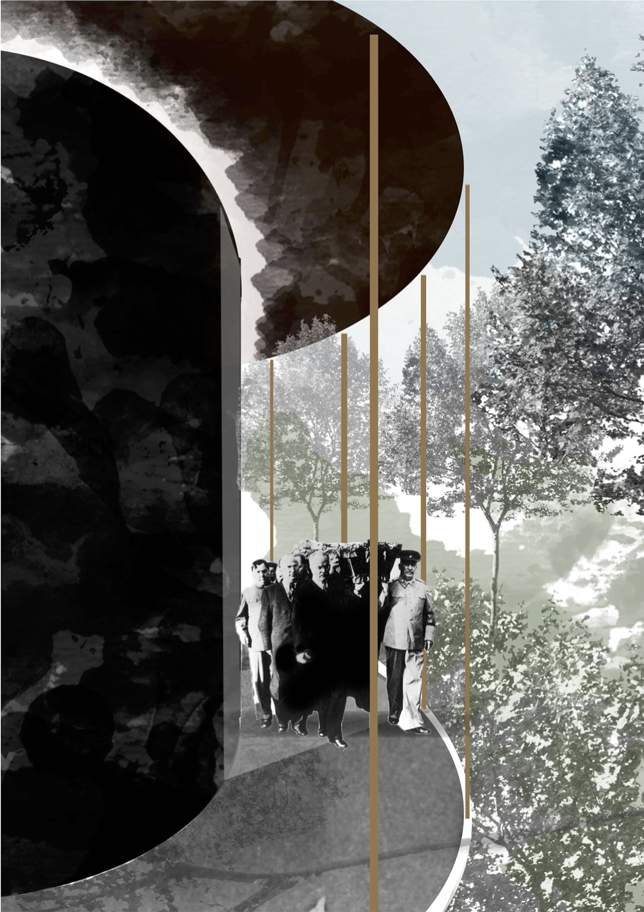
The final project returned to writing as an informer of architectural space, where the project culminated in a hauntingly elegant flue of ash (see Figure 9), where ‘the transition from stagnation to movement, cues the procession to allow themselves to grieve, yet not to be consumed’ (Woo, 2015; Personal communication).
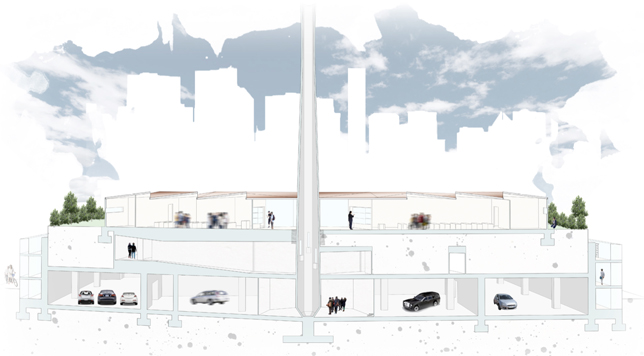
Student A employed the writing of prose, reflection and translation to new drawing in the imaging of architectural space providing mental health services (see Figure 10).
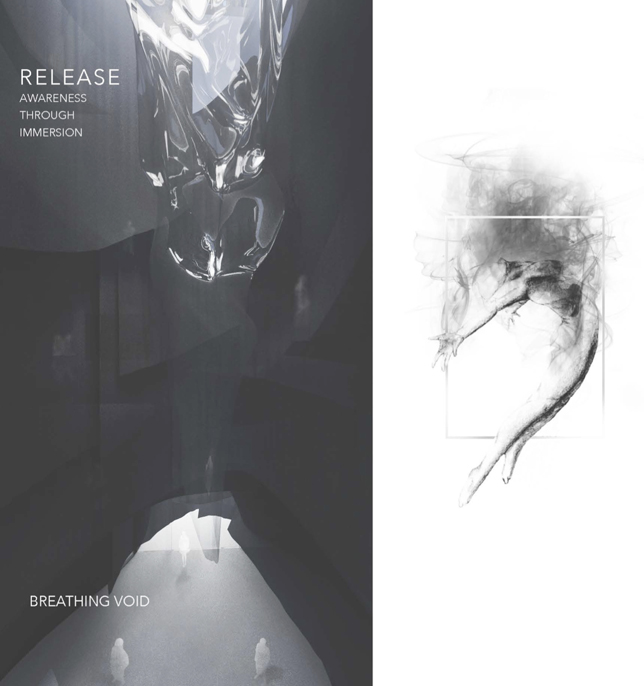
His prose fiction imaging each of the key spaces in his final design outcome became, in a sense, the brief to which his architecture responded. This process allowed him to transcend the purely visual matter of architecture, and the prose was a key self-reported means to develop an empathetic connection with the intended inhabitants of his imagined architectural spaces. Knowledge here is tested between visual and textual modes, allowing insight to be developed, refined, translated and legitimised in architecture.
5. Implications and conclusions
This design process employing poetry and prose fiction is significant in a series of key ways. As outlined in the previous section, the use of poetry and prose fiction helped the students to develop clarity within their design responses. It gave them an overall structure to follow when designing spatial experiences, and helped them to develop individual design briefs/agendas with creativity and insight. This method offers a new vehicle to source inspiration, define user experiences, and create new and interesting views through design practice. Integrating poetry to design processes enabled synthesis between the creative and the critical, leading to greater rigour and critical reflection within design processes and outcomes.
Using poetry and prose fiction in the design process served to disrupt the students’ habitual processes of making and executing their design practice. By adopting a hitherto untested design methodology, the students were faced with uncertainty, and forced to quickly become willing to experiment, and occupy a working space where failure may occur. A willingness to fail productively is necessary to elicit innovation (Winter et al. 2010); by introducing these new design methodologies, students were tasked with quickly becoming comfortable, or at least productive, in unfamiliar and uncertain problem spaces. As indicated by survey responses,[xiii] this served to increase the students’ abilities to trust themselves, and perceive their own capabilities to make important decisions about their own processes of design and learning.
The generation of poetry and prose fiction was a useful tool to support the generation and expression of architecture. Purposeful writing by students of architecture offered them a new lens to re-interrogate their work, their assumptions made and conclusions inferred, which allowed the generation of new drawings enabled by embracing a different type of dialogue. Students reported that this was a meaningful avenue for expression, and helped them to overcome ‘designers’ block’ by offering a different mode in which to be creative and brainstorm ideas. Here the writing served as a substitute for drawing as a means to record, develop and reflect upon ideas. It also assisted in making the students more comfortable with the ‘wicked problem’ of the multitude of possible design solutions to any one design task. It seems that the imagined need to find the ‘perfect’ solution was less apparent when undertaking reflective writing activities, and thus there was more of a focus on exploring the issue at hand, and developing a richer understanding, as opposed to the often self-paralysing need to ‘get it right.’
In writing their own verbal and textual prose, some students explained their thinking process, seemingly aware of what they were doing and why. This written expression serves as a catalyst to increase self awareness in design thinking. As noted, the creative design process is acknowledged as complex, and designers rarely articulate their own design thinking, yet possessing such self awareness is understood as a means to achieving greater levels of critical rigour in design outcomes. Thus, the increase in self awareness developing from the writing of poetry and prose fiction was a particularly powerful learning outcome. Design activities that dealt with more abstract, reflective practice and knowledge making, were engaged by students for evaluation or analysis purposes, and assisted most usefully in the development of self-awareness in relation to design decision-making and design thinking.
The inclusion of poetry and prose fiction in the design process permitted a great deal of iterative testing; a design process is not linear, typically moving back and forth across different phases (Brian 2005) and the writing of poetry and prose was a tool which could be readily employed across phases. This allowed the students to engage poetic writing at multiple points in order to review and reflect, modify design solutions, address issues, and enhance ideas through the development of the final design outcome.
This paper encourages a reflection upon the possibilities of poetry and prose fiction within the architectural design studio, and design teaching. It is useful to aid students in imagining, clarifying and structuring design responses. It also increases communication skills, critical engagement and reflection. This paper is suggestive of the purposeful use of writing within the architectural design studio context as a lens through which students may re-examine their work, briefs and agendas, and engage a new kind of dialogue to communicate and express their work to others. This has the potential to be more engaging, inclusive and collaborative, and thus more central to the process of making architecture.
Acknowledgement
The author would like to extend gratitude to Rebecca McLaughlan who contributed to the teaching delivery of the masters studios ‘I Remember, You Remember’ and ‘A House for Unrequited Love.’ The author would also like to thank the students of architecture who have shared their work in this publication.
[i] This research has ethics clearance from The University of Melbourne (ethics ID no. 1748813).
[ii] Tibballs, M 2016 Process work, Studio Fire course
[iii] Tibballs, M 2016 Process work, Studio Fire course
[iv] Potter, O 2017 Process work, A House for Unrequited Love design studio
[v] Potter, O 2017 Process work, A House for Unrequited Love design studio
[vi] Yuen, S 2016 Process work, I Remember, You Remember design studio
[vii] Yuen, S 2016 Process work, I Remember, You Remember design studio
[viii] Yuen, S 2016 Process work, I Remember, You Remember design studio
[ix] Yuen, S 2016 Process work, I Remember, You Remember design studio
[x] Woo, C 2016 Process work, I Remember, You Remember design studio
[xi] Woo, C 2016 Process work, I Remember, You Remember design studio
[xii] Tibballs, M 2016 Process work, Studio Fire course
Abdelhameed, W 2011 ‘Architectural form creation in the design studio: Physical modelling as an effective design tool’ International Journal of Architectural Research, 20: 2, 81-92
Brian, B 2005 ‘Architectural design process and its phases’, at http://www.bluentcad.com/architecture/architectural-design-process.shtml (accessed 12 October 2017)
Caballero, R 2014 ‘Thinking, drawing and writing architecture through metaphor’, Iberica, 28, 155-180
Collidge, R T 2013 ‘The architectural process’, at http://www.robertcoolidge.com/process-1.html (accessed 12 October 2017)
Coyne, R 2005 ‘Wicked problems revisited’, Design Studies, 26: 1, 5-17
Deshler, D 1990 ‘Metaphor analysis: Exorcising social ghosts’, in J Mezirow (ed) Fostering critical reflection in adulthood, San Francisco: Jossey-Bass, 79-88
Ferguson, E S 1992 Engineering and the mind's eye, Cambridge: The MIT Press
Flewitt, R, Hampel, R, Hauck, M, & Lancaster, L 2009 ‘What are multimodal data and transcription?’, in C. Jewitt (ed) The Routledge Handbook of multimodal analysis, New York: Routledge, 40-53
Goldschmidt, G 2003 ‘The backtalk of self-generated sketches’, Design issues, 19: 1, 72-88
Golembiewski, J 2014 ‘Building a Better World: Can Architecture Shape Behaviour?’, The Conversation at http://theconversation.com/building-a-better-world-can-architecture-shape-behaviour-21541 (Accessed 12 October 2017)
Jewitt, C 2009 ‘An introduction to multimodality’, in C. Jewitt (ed) The routledge handbook of multimodal analysis, New York: Routledge, 14-27
Kowaltowski, D C C K, Bianchi, G, & Teixeira de Paiva, V 2009 ‘Methods that may stimulate creativity and their use in architectural design education’, International Journal of Technology and Design Education, 20, 453-476
Leander, K, & Vasudevan, L 2009 ‘Multimodality and mobile culture’, in C. Jewitt (ed) The Routledge handbook of multimodal analysis, New York: Routledge, 127-139
Marinic, G 2011 ‘(re)Presenting Precedents: A convergence of art and architecture’, The International Journal of Arts in Society, 6: 1, 1833-1866
Rittel, H, & Webber, M 1973 ‘Dilemmas in a general theory of planning’, Policy Sciences, 4, 155-169
Saban, A 2006 ‘Functions of metaphor in teaching and teacher education: A review essay’, Teaching Education, 17, 299-315
Soliman, A M 2017 ‘Appropriate teaching and learning strategies for the architectural design process in pedagogic design studios’, Frontiers of Architectural Research, 6, 204-217
Suwa, M, Tversky, B, Gero, J, & Purcell, T 2001 ‘Seeing into sketches: Regrouping parts encourages new interpretations,’ in M. Suwa, B. Tversky, J. Gero, & T. Purcell (eds), Visual and Spatial Reasoning in Design II, Australia: University of Sydney, Australia: Key Centre of Design Computing and Cognition, 207-219
Turkle, S 2007 ‘What makes an object evocative?’ in S. Turkle (ed), Evocative objects: Things we think with, Cambridge, Massachusetts: MIT Press, 307-326
Winter, M, Gorman, M J, Brunswick, I, Browne, D, Williams, D, & Kidney, F 2010 ‘Fail better: lessons learned from a formative evaluation of social object labels’ paper presented at the PATCH'15 Proceedings of the 8th International Conference on Personalized Access to Cultural Heritage, Atlanta